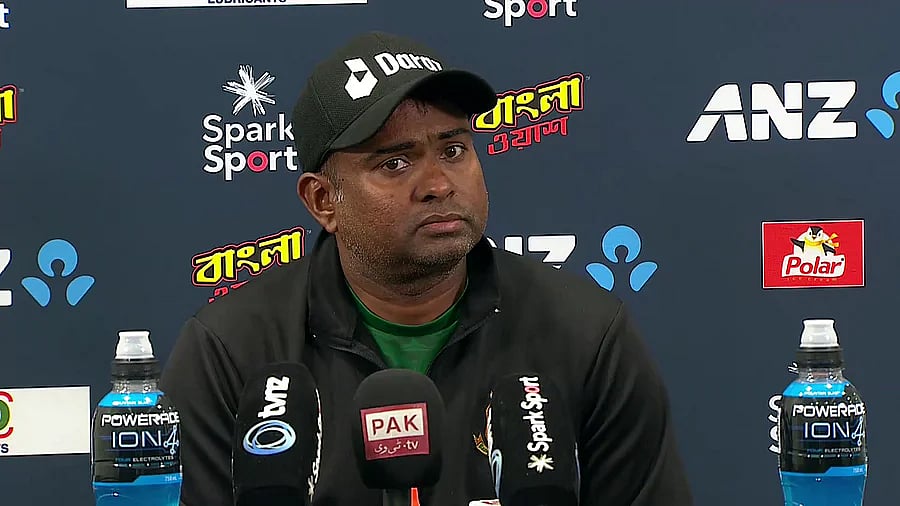
The impact of Sriram’s ‘impact cricket’
Irony went into overdrive in the just-concluded tri-nation series between Bangladesh, New Zealand and Pakistan as in the series, which was called ‘Bangla Wash T20I Tri-series’, it was Bangladesh who got ‘Bangla Washed’.
The Tigers lost twice against Pakistan and New Zealand respectively to conclude their final T20I series before the ICC T20 World Cup in Australia empty-handed.
The buzzword surrounding the team heading into the tri-series was ‘impact cricket’. The T20 team’s technical director Sridharan Sriram prescribed this as the solution to Bangladesh’s woes in the shortest format of the game.
In Sriram’s own words, “I think performance is overrated in T20 cricket. A team could still lose if they have performers. But if we have more impact, chances are, we will win more games.”
The former India international said this in his first official press conference after assuming the role in Bangladesh.
In that media interaction, Sriram, who is also the team’s impromptu head coach at the moment as Bangladesh currently has none in the format, also explained exactly what he meant by ‘impact’.
“I am looking for impact, not performance. Bangladesh will win if seven or eight players make an impact. A 30 or 25, off 17-18 balls is impact for me.”
Since then, the Tigers have played eight T20Is. But Sriram’s arrival is yet to make an ‘impact’ on Bangladesh’s fortune in the format.
Unchanged win-loss ratio
Since Sriram arrived, Bangladesh has won two matches against the United Arab Emirates (UAE) while losing thrice to Pakistan, twice against New Zealand and once against Sri Lanka.
In the eight completed T20Is before Sriram’s appointment, Bangladesh’s win-loss ratio was identical with two wins and six losses.
They suffered two defeats each against Zimbabwe and the West Indies, and one each against Pakistan and Afghanistan.
Their only wins came over Afghanistan and Zimbabwe.
Win-loss ratio, however, is not always a fair indicator of a team’s improvement. To understand whether a team is heading towards the right direction, the stats need to be closely examined.
Scoring a bit more, conceding a lot more
In the eight T20Is before Sriram’s appointment, Bangladesh scored 7.56 runs per over while conceding 7.80, meaning they were trailing their opponents by 0.24 runs.
In the last eight T20Is, Bangladesh’s scoring rate has improved, as they made 7.83 runs on average per every six balls.
But this slight improvement hasn’t aided them as in the same period their bowlers have conceded 8.35 runs per over.
Ray of hope
These stats may make it seem like the Bangladesh Cricket Board’s (BCB) decision to rope in the former Australia assistant coach has been a complete bust. But that assessment would be a bit harsh.
Since Sriram’s arrival, Bangladesh has only played away from home. Compared to the eight away T20Is before the Indian coach’s arrival, Bangladesh’s scoring rate has improved and rate of conceding runs has slightly reduced.
In the eight away T20Is before Sriram, Bangladesh’s scoring rate was 7.27 runs per over, which has increased by 0.6 runs in the last eight games.
On the other hand, the rate of conceding runs has also reduced marginally by 0.07 runs, but at least it’s a step in the right direction for the team.
Search for impact players
The team’s attempt to adopt Sriram’s philosophy of ‘impact cricket’ was visible in the tri-nation series, as was how far the players are from executing Sriram’s vision.
Sriram wants the openers to take on the bowlers, batters to play brisk cameo knocks throughout the innings and the bowlers to grab the crunch moments of the match.
But the reality is, there aren’t enough players in the Bangladesh squad that can execute his plans.
In search of instant impact, the management has chopped and changed the playing XI in the tri-nation series but no combination could bring them their desired outcome.
Bangladesh next has two practice matches against Afghanistan and South Africa in Brisbane on 17 and 19 October respectively before they face the runners-up of Group A in their opening match of the T20 World Cup in Hobart on 24 October.
In all likelihood, Bangladesh will not magically transform into a team that can compete and win against top sides in around 10 days.
The best Bangladesh can hope for is that the team’s performance graph keeps moving upwards and the impact of ‘impact cricket’ doesn’t completely fade away in the World Cup.